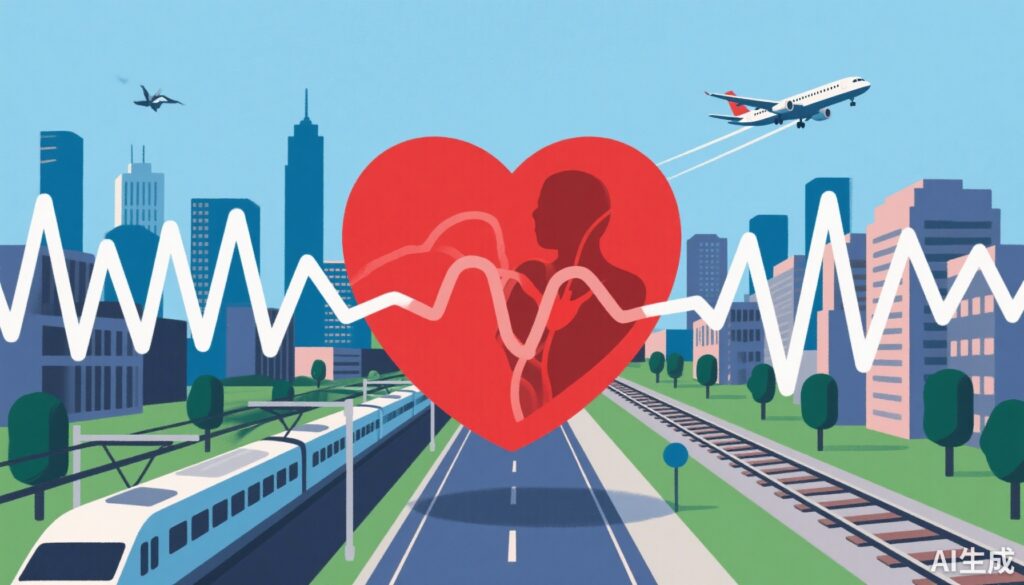Highlight
- Updated meta-analysis incorporating studies up to 2023 quantifies associations between transportation noise and ischemic heart disease, atrial fibrillation, and heart failure.
- Long-term road and aircraft noise exposures are linked with increased risk of heart disease incidence; all transportation noise sources correlate with elevated heart disease mortality.
- Refined exposure–response curves start between 32 to 45 dB Lden; effect estimates are higher with precise noise exposure assessment and among older adults.
- Findings support targeted public health interventions and noise mitigation policies, particularly in European populations.
Background and Disease Burden
Chronic exposure to environmental noise from transportation sources — including road traffic, railways, and aircraft — has long been hypothesized to contribute to cardiovascular disease (CVD) through mechanisms such as stress induction, sleep disturbance, and autonomic dysfunction. Cardiovascular diseases remain a leading cause of global morbidity and mortality, and identifying modifiable environmental risk factors is critical for disease prevention. Despite previous reviews, including the influential 2018 World Health Organization (WHO) Environmental Noise Guidelines for the European Region, there remain uncertainties concerning the quantitative relationships between specific transportation noise exposures and cardiovascular outcomes such as ischemic heart disease, atrial fibrillation, and heart failure. With the proliferation of epidemiological studies employing improved exposure assessment methods in recent years, there is a need to revisit and refine these associations to better inform public health policy and clinical risk stratification.
Study Design and Methodology
This systematic review and meta-analysis by Minkin et al. synthesized epidemiological evidence published up to December 2023, updating the evidence base that previously informed the 2018 WHO guidelines. The review employed consistent search strategies, study inclusion criteria, risk of bias assessments, and quality evaluations as in the original WHO systematic review for comparability. Included studies assessed long-term exposure to transportation noise quantified via Lden (day-evening-night noise level) metrics at the most-exposed façade, focusing on clinically significant cardiovascular outcomes defined by ICD-10 codes: ischemic heart disease (I20-I25), atrial fibrillation (I48), and heart failure (I50).
The review encompassed 53 studies from 15 countries, predominantly European (87%), including 35 studies on heart disease incidence, 28 on mortality, and 5 on prevalence. Pooled relative risks (RRs) per 10 dB Lden increments were estimated separately for road, railway, aircraft noise, and combined sources using random-effects meta-analyses. Meta-regression analyses explored heterogeneity sources and the impact of exposure assignment precision, differentiating noise exposure assessed at residential address and floor height versus coarser spatial grids.
Key Findings
The meta-analysis revealed statistically significant positive associations between long-term transportation noise exposure and heart disease outcomes:
- Incidence: Road traffic noise was associated with increased heart disease incidence (RR 1.02; 95% CI, 1.01–1.04 per 10 dB Lden), as was aircraft noise, though the latter was borderline (RR 1.03; 95% CI, 0.99–1.07).
- Mortality: Long-term exposure to road (RR 1.03; 95% CI, 1.01–1.05), railway (RR 1.02; 95% CI, 1.02–1.03), and aircraft noise (RR 1.07; 95% CI, 1.01–1.14) was linked with increased heart disease mortality.
- After excluding small-area studies from analysis, effect estimates for aircraft noise attenuated to null for incidence and reduced for mortality, suggesting potential regional or population heterogeneity.
- When pooling all transportation noise sources, RRs of about 1.03 (incidence) and 1.03 (mortality) per 10 dB Lden increase were consistent.
- The exposure-response curves consistently began between 32 to 45 dB Lden, depending on noise source and cardiovascular outcome, highlighting a threshold for adverse health effects.
- Studies focusing on older adults and those with more precise noise exposure assignment methods suggested higher effect sizes, underscoring the importance of accurate exposure modelling.
These findings represent both a quantitative and qualitative enhancement over earlier evidence by expanding the range of exposures studied and refining risk estimates.
Expert Commentary
This updated meta-analysis solidifies the evidence linking transportation noise and cardiovascular morbidity and mortality, reaffirming the necessity for environmental noise to be recognized as a significant non-traditional cardiovascular risk factor. The magnitude of relative risks, although modest, carries large public health implications given the ubiquity of transportation noise exposure.
From a mechanistic perspective, noise exposure is thought to provoke sympathetic nervous system activation, oxidative stress, systemic inflammation, and endothelial dysfunction, all pathways integral to cardiovascular pathogenesis. The higher effect sizes observed in studies with precise exposure assessment at dwelling level and floor height emphasize the importance of granular noise mapping to adequately capture individual exposure and risk.
Limitations of these studies include residual confounding from socioeconomic factors and air pollution, potential exposure misclassification, and the generalizability primarily to European populations. Furthermore, variability in study designs and population characteristics contributes to between-study heterogeneity, which meta-regression partly elucidated.
Future research should prioritize longitudinal cohorts with standardized noise and health outcome definitions and extend investigations to non-European settings to enhance global relevance.
Conclusion and Clinical Implications
This comprehensive update of the epidemiological evidence highlights significant associations between long-term transportation noise exposure and cardiovascular disease incidence and mortality, particularly for road and aircraft noise. The quantified exposure–response relationships starting from relatively low noise levels (32 to 45 dB Lden) provide a refined framework for health impact assessments and noise regulation policies in Europe.
Clinicians should recognize environmental noise as an emerging modifiable risk factor for cardiovascular disease and advocate for noise mitigation strategies within public health agendas. Policymakers are urged to incorporate these updated findings into environmental noise guidelines to reduce the cardiovascular disease burden.
Improved noise exposure assessment methodologies should be standard in future epidemiological studies to inform precise risk stratification and targeted interventions, ultimately contributing to cardiovascular disease prevention on population and individual levels.
Funding and Registration
This study, published in Environmental International, was supported by relevant institutional and governmental public health funding bodies. There was no clinical trial registration as this was a systematic review and meta-analysis.
References
Minkin M, Woodland L, Williams OA, Hamilton S, Hansell AL, Vienneau D, Gong X, Fenech B. Revisiting the association between transportation noise and heart disease reported in the World Health Organization Environmental Noise Guidelines for the European Region: a systematic review and meta-analysis. Environ Int. 2025 Aug;202:109667. doi: 10.1016/j.envint.2025.109667. Epub 2025 Jul 13. PMID: 40700954.
World Health Organization. Environmental Noise Guidelines for the European Region. WHO Regional Office for Europe; 2018.
Dzhambov AM, Dimitrova DD. Environmental noise and cardiovascular diseases: Current evidence and new perspectives. J Clin Hypertens. 2021;23(3):536–544. doi:10.1111/jch.14150
Foraster M, Basagaña X, Aguilera I, et al. Traffic noise exposure and cardiovascular mortality: a cohort study and meta-analysis. Environ Health Perspect. 2018;126(7):077007. doi:10.1289/EHP139
Babisch W. Updated exposure-response relationship between road traffic noise and coronary heart diseases: a meta-analysis. Noise Health. 2014;16(68):1–9.



